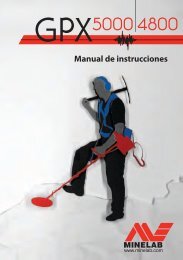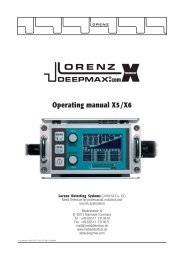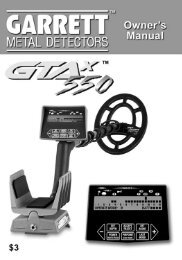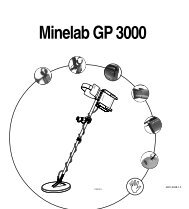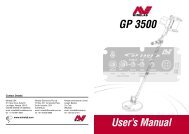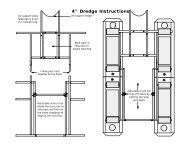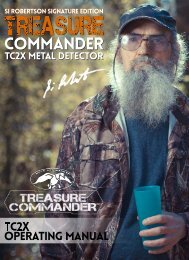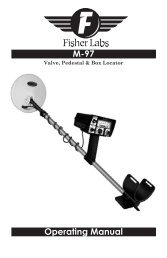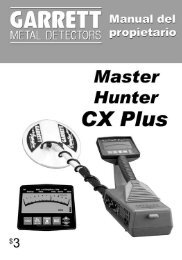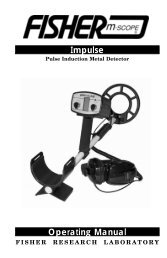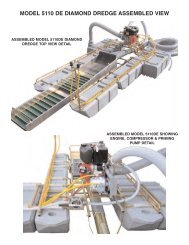sea hunters xl500 and xs500 (vlf) - Garrett
sea hunters xl500 and xs500 (vlf) - Garrett
sea hunters xl500 and xs500 (vlf) - Garrett
Create successful ePaper yourself
Turn your PDF publications into a flip-book with our unique Google optimized e-Paper software.
OPERATING INSTRUCTIONS:<br />
SEA HUNTERS XL500 AND XS500 (VLF)<br />
MODEL DESCRIPTIONS<br />
Two Sea Hunter underwater metal detector models are produced by <strong>Garrett</strong> Electronics.<br />
These two models, XS500 <strong>and</strong> XL500, are basically the same electronically. They differ in<br />
<strong>sea</strong>rchcoil type, mechanical configuration, <strong>and</strong> in the manner in which they are used.<br />
CAPABILITIES<br />
The capabilities of the Sea Hunter are many. In fact, no other underwater detector can<br />
perform all the tasks the Sea Hunter is capable of performing. The Sea Hunter can be<br />
operated both in water <strong>and</strong> over dry l<strong>and</strong>. The XL500 is especially suited for this dual role, as<br />
it is equipped with both long <strong>and</strong> short stems. The XS500 is designed primarily for underwater<br />
work. Both detectors are identical except for <strong>sea</strong>rchcoil design <strong>and</strong> stem configuration. The<br />
Sea Hunter can be used in fresh, brackish, or high salinity water. The detector can be used<br />
over ground that has iron or salt minerals or over ground that has no minerals. The Sea<br />
Hunter can be used by prospectors in high iron mineralized areas. Gold <strong>and</strong> silver nuggets,<br />
veins, pockets, <strong>and</strong> black s<strong>and</strong> concentrations, on l<strong>and</strong> <strong>and</strong> under water, can be readily<br />
detected. The operator may choose either MANUAL or AUTOMATIC operation, depending<br />
upon his/her particular operating requirements.<br />
<strong>Garrett</strong> Sea Hunter instruments are professionally built to perform most every underwater/l<strong>and</strong><br />
task required of them. The Sea Hunter instruments use VLF/TR (Very Low Frequency<br />
Transmitter-Receiver) circuitry. With simple adjustments of the TEN TURN ELIMINATOR<br />
control, the full capabilities of the Sea Hunter circuitry can be achieved. A brief discussion of<br />
the earth’s ground <strong>and</strong> water minerals will tell why the ELIMINATOR control is needed.<br />
Many of the minerals found on the earth’s surface <strong>and</strong> in the oceans are quite common <strong>and</strong><br />
occur with great frequency. Two of these can interfere with metal detector operation: iron <strong>and</strong><br />
salt. Natural iron is similar in appearance to iron rust <strong>and</strong> in a certain form is often referred to<br />
as “black magnetic s<strong>and</strong>” because of its dark color. Salt is a problem when it is wet. It<br />
becomes conductive <strong>and</strong> a metal detector responds to it the same as it would to metal. These<br />
two minerals, in most cases, create undesirable detector responses <strong>and</strong> operating problems.<br />
The ELIMINATOR control on the <strong>Garrett</strong> Sea Hunter has an extremely wide adjustment range<br />
that lets the operator dial out or ELIMINATE troublesome ground <strong>and</strong> water minerals. This<br />
same control allows the operator to discriminate against or ELIMINATE detection of iron rust<br />
<strong>and</strong> trash metals. The ten-turn feature of the ELIMINATOR control extends the adjustment<br />
range <strong>and</strong> gives the operator extremely fine <strong>and</strong> accurate adjustment capability. Operation of<br />
the ELIMINATOR control is explained later in these instructions.<br />
SEA HUNTER XS500: Designed basically for underwater operation. While it can be used on<br />
l<strong>and</strong>, there are no provisions for long stem operation since the short stem is permanently
attached to the control housing. The short stem of the Sea Hunter XS500 allows the operator<br />
to dig <strong>and</strong> retrieve detected objects by simply extending his or her free arm ahead to a point<br />
where the <strong>sea</strong>rchcoil indicates the presence of an object.<br />
The XS500 can be used with or without the arm guide <strong>and</strong> the headphones. When the<br />
headphones are not used, the operator can rely upon the meter <strong>and</strong> indicator lights <strong>and</strong> need<br />
not worry about protecting the headphone/recharge connector from water.<br />
SEA HUNTER XL500: Designed for both l<strong>and</strong> <strong>and</strong> underwater operation. The capability of<br />
mounting the control housing on the hip or on the upper body greatly reduces weight fatigue<br />
while <strong>sea</strong>rching on l<strong>and</strong>. When the XL500 is used in the long stem configuration, the detector<br />
may also be conveniently used when wading. The XL500 can be used to any depth up to 200<br />
feet (65 meters) maximum depth. Should the operator prefer short stem configuration, the<br />
control housing is preferably attached to the waist or upper body by the straps which are<br />
provided. Care should be taken to insure that the straps are attached so as not to interfere<br />
with other equipment, weight belts, etc.<br />
CONTROL FUNCTIONS<br />
In addition to the HEADPHONES/RECHARGE CONNECTOR which will be explained later,<br />
there are three CONTROL PANEL knobs (left to right): TUNING CONTROL; OFF/SEARCH<br />
MODE/BATTERY CHECK SELECTOR; <strong>and</strong> TEN-TURN ELIMINATOR.<br />
ELIMINATOR CONTROL: Permits the operator to adjust the detector to ELIMINATE detection<br />
of GROUND MINERALS, SALT WATER, <strong>and</strong> TRASH. When the ELIMINATOR control is<br />
adjusted, the following operating characteristics will be noted.<br />
♦ Ground Mineral Elimination: When the detector is adjusted to eliminate natural iron<br />
mineral which is found in most of the earth’s soil, especially in areas that contain gold,<br />
silver, <strong>and</strong> other precious metals, the detector will detect almost all metals, including gold,<br />
silver, platinum, copper, bronze, foil, <strong>and</strong> refined iron. Salt water will be detected slightly.<br />
♦ Fresh Water Elimination: The detector will be operated in fresh water with the<br />
ELIMINATOR control set at the GROUND MINERAL, SALT WATER, or TRASH setting.<br />
Operation will be the same at all three settings, but often the bottom <strong>and</strong> beach areas of<br />
fresh water lakes <strong>and</strong> streams contain natural iron mineral. Consequently, if the operator<br />
notices that the ground or stream bottom “disturbs” the detector slightly (difficult to maintain<br />
steady threshold tuning), then the ELIMINATOR control can be adjusted to reduce or<br />
eliminate detection of these natural iron minerals.<br />
♦ Salt Water Elimination: When the detector is adjusted to eliminate salt water, the detector<br />
will detect almost all solid (refined) metals, including gold, silver, platinum, copper, bronze,<br />
<strong>and</strong> large pieces of iron. Natural iron ground minerals also will be detected slightly. Small<br />
iron nails, rusty iron, <strong>and</strong> small pieces of iron will be eliminated. If the operator is <strong>sea</strong>rching<br />
in the ocean <strong>and</strong> wishes to detect all metals, INCLUDING small iron nails, rusty iron, <strong>and</strong><br />
small pieces of iron, it will be necessary to rotate the ELIMINATOR control perhaps FULLY<br />
COUNTERCLOCKWISE. At this setting, salt water will be detected slightly. To insure the
control is rotated FULLY COUNTERCLOCKWISE, rotate the control ten turns<br />
COUNTERCLOCKWISE. (see also SPECIFICATIONS, IMPORTANT TUNING NOTE.)<br />
♦ Trash Elimination: When the detector is adjusted to eliminate detection of trash, the<br />
detector will detect almost all solid (refined) metals, such as gold, silver, platinum, copper,<br />
bronze, <strong>and</strong> large pieces of iron. The detector may detect natural iron mineral <strong>and</strong> salt<br />
water slightly.<br />
♦ Note: The Sea Hunter contains sophisticated, state-of the-art electronic circuits which give<br />
the operator an extremely wide range of operating characteristics <strong>and</strong> capabilities. The<br />
operator should learn the above ELIMINATOR control settings to achieve maximum<br />
performance from the Sea Hunter.<br />
OFF/SEARCH MODE/BATTERY CHECK SELECTOR: This is the main power/mode/battery<br />
check control. The operator can select either Manual or Automatic <strong>sea</strong>rch mode or check the<br />
batteries.<br />
TUNING CONTROL: This control allows the operator to “tune” the detector by adjusting the<br />
audio or meter to the desired level.<br />
OPERATING INSTRUCTIONS<br />
SIMPLIFIED OPERATING INSTRUCTIONS: So that the operator may learn to adjust the Sea<br />
Hunter for most operating conditions quickly, the following simplified operating instructions are<br />
given. These are the same instructions printed on the Sea Hunter top label. (Make<br />
adjustments <strong>and</strong> check batteries before diving.) Slight readjustments may be required when<br />
submerged.<br />
ROTATE:<br />
1) CENTER KNOB TO AUTOMATIC<br />
2) LEFT KNOB FOR FAINT SOUND<br />
3) RIGHT KNOB TEN TURNS COUNTERCLOCKWISE, THEN ADJUST FOR ONE OF THE<br />
FOLLOWING:<br />
a) GROUND ELIMINATION or FRESH WATER OPERATION: Rotate ONE TURN<br />
CLOCKWISE, then small plus/minus (+ or -) adjustments as needed to achieve no<br />
audio sound change as <strong>sea</strong>rchcoil is quickly lowered to two inches above ground.<br />
b) SALT WATER ELIMINATION: Rotate SIX TURNS CLOCKWISE, then small plus/minus<br />
(+ or -) adjustments as needed to achieve no audio change as <strong>sea</strong>rchcoil is quickly<br />
lowered to the bottom. Start with the <strong>sea</strong>rchcoil below the surface of the water.<br />
c) TRASH ELIMINATION: No trash eliminations, NO TURNS; rusty iron, THREE TURNS;<br />
small iron trash, TEN TURNS CLOCKWISE.<br />
Search in AUTOMATIC or set to MANUAL <strong>and</strong> retune (step 2) as needed.<br />
EXPANDED OPERATING INSTRUCTIONS: These exp<strong>and</strong>ed instructions are given so that<br />
the operator will have a better underst<strong>and</strong>ing of the detector controls <strong>and</strong> capabilities.
Tuning Control: Permits the operator to adjust the level of tuning. THE OPTIMUM, MOST<br />
SENSITIVE TUNING POINT (CALLED THRESHOLD) IS WHEN THE SOUND, AS HEARD<br />
THROUGH THE HEADPHONES, IS BARELY AUDIBLE. The Tuning Control should not be<br />
adjusted for a loud sound. It should be adjusted so that when the detector is not detecting<br />
metal, the audio sound is barely discernable.<br />
Off/Search Mode/Battery Check Selector: The five positions of this control are described as<br />
follows:<br />
♦ OFF: All battery power is turned OFF in this position<br />
♦ MANUAL: All battery power is turned ON in this position. The detector is operating in the<br />
MANUAL MODE. When any environmental or detector changes (temperature, battery<br />
voltage change, etc.) cause the detector TUNING LEVEL to change, it is necessary to<br />
adjust the TUNING CONTROL to achieve FAINT THRESHOLD SOUND as explained in<br />
the preceding Tuning Control paragraph. To set or reset the THRESHOLD, simply turn the<br />
TUNING CONTROL to the desired position.<br />
♦ AUTOMATIC: All battery power is turned ON. The detector is operating in the<br />
AUTOMATIC MODE. The detector’s circuit AUTOMATICALLY RETUNES THE<br />
DETECTOR TO THE OPERATOR’S PRE-SET THRESHOLD when any environmental or<br />
detector changes occur. Should the TUNING CONTROL be bumped or accidentally<br />
turned, the THRESHOLD must again be reset according to the instructions given in the<br />
TUNING CONTROL paragraph.<br />
♦ BATTERY CHECK 1: In this position, the batteries for the detection circuit are checked.<br />
The detector should be operated for at least one minute before the batteries are checked.<br />
When the meter pointer drops to the left of the BATTERY ZONE or when detector<br />
operation becomes erratic, batteries should be recharged. (See following paragraphs on<br />
NiCad rechargeable batteries.)<br />
♦ BATTERY CHECK 2: In this position, the battery for the audio circuit is checked.<br />
Eliminator Control: This TEN TURN control gives the operator sufficiently wide range tuning<br />
to set the detector to perform any task <strong>and</strong> operate under all environmental <strong>and</strong> ground/water<br />
conditions. Depending upon whether the operator wants to operate over the earth’s iron<br />
mineralized ground, in or over salt water, or to eliminate detection of trash items, the<br />
ELIMINATOR control should be adjusted as described below. (See SPECIFICATIONS,<br />
IMPORTANT TUNING NOTE.)<br />
1) Turn the center control to MANUAL or AUTOMATIC. AUTOMATIC is easier because the<br />
detector’s circuit keeps the audio THRESHOLD set automatically.<br />
2) Adjust the left knob for faint THRESHOLD sound.<br />
3) Rotate the ELIMINATOR control ten turns COUNTERCLOCKWISE, then adjust for one of<br />
the following:<br />
a) GROUND ELIMINATION OR FRESH WATER OPERATION: Rotate the control one<br />
turn CLOCKWISE. Lower the <strong>sea</strong>rchcoil quickly to two inches above the ground or<br />
bottom. If no audio or meter change is observed, the detector is correctly tuned for the<br />
ground or water. (A small audio or meter change may be acceptable.) If there is an<br />
INCREASE in the audio or meter indication, rotate the ELIMINATOR control about onehalf<br />
turn CLOCKWISE (toward “+”). If the detector is operating in MANUAL, a slight<br />
adjustment of the TUNING CONTROL may be necessary to bring the detector back to<br />
the AUDIO THRESHOLD.
Quickly lower the <strong>sea</strong>rchcoil to two inches above the ground or bottom. If no audio or<br />
meter change is noted, the detector is correctly tuned. If, however, the audio or meter<br />
indicates a DECREASE, the ELIMINATOR CONTROL has been rotate CLOCKWISE<br />
too far. Rotate the control one-quarter turn COUNTERCLOCKWISE (toward “-“) <strong>and</strong><br />
again test by quickly lowering the <strong>sea</strong>rchcoil to two inches above the ground or bottom.<br />
Continue this procedure until no (or slight) change is noted in the audio <strong>and</strong> meter.<br />
b) SALT WATER ELIMINATION: Rotate the control six turns CLOCKWISE. Begin with the<br />
<strong>sea</strong>rchcoil well below the surface of the water <strong>and</strong> lower it quickly to the bottom. If there<br />
is not (or small) audio <strong>and</strong> meter change, the detector is correctly tuned for salt water<br />
operation. If <strong>and</strong> INCREASE or a DECREASE in the audio or meter is noted, follow the<br />
same procedure given under section “a” until there is no (or slight) change in the audio<br />
or meter.<br />
c) TRASH ELIMINATION: Rotate the control:<br />
NO TURNS for NO TRASH ELIMINATION (detect all metals);<br />
THREE TURNS for RUSTY IRON ELIMINATION;<br />
TEN TURNS for SMALL IRON TRASH ELIMINATION.<br />
Test “ELIMINATION” by quickly bringing the chosen trash target sample to within one<br />
inch of the bottom of the <strong>sea</strong>rchcoil. If the trash target produces an increase in the<br />
audio <strong>and</strong> meter, rotate the control one-half turn further CLOCKWISE <strong>and</strong> test again.<br />
Continue slight adjustments until the trash target you want to eliminate causes no<br />
increase in audio or meter. NOTE: Small aluminum trash, such as pulltabs <strong>and</strong> screw<br />
caps, <strong>and</strong> large pieces of most metals cannot be eliminated.<br />
Important Notes:<br />
1) If your Sea Hunter is equipped with a CO-PLANAR <strong>sea</strong>rchcoil (st<strong>and</strong>ard on XL500), an<br />
INCREASE in audio <strong>and</strong> meter will be noted when your selected TRASH TARGET is<br />
brought closer than one inch to the bottom of the <strong>sea</strong>rchcoil. This “back reading” effect<br />
does not occur with CO-AXIAL <strong>sea</strong>rchcoils which are st<strong>and</strong>ard on the XS500.<br />
2) When any type detector is operated in AUTOMATIC MODE <strong>and</strong> the detector is adjusted to<br />
eliminate (discriminate against) trashy iron objects, an “overshoot” phenomenon occurs.<br />
You can observe this for yourself. Set your detector to AUTOMATIC <strong>and</strong> adjust<br />
ELIMINATION until the detector produces no audio or meter change when, for example, a<br />
small nail is brought up to within one inch of the bottom of the <strong>sea</strong>rchcoil.<br />
At a moderate or normal speed, move the nail past the <strong>sea</strong>rchcoil, keeping the nail at least<br />
one inch away from the bottom of the <strong>sea</strong>rchcoil. You will note that as the nail approaches<br />
the bottom of the <strong>sea</strong>rchcoil, the audio <strong>and</strong> meter will DECREASE slightly. Then, as the<br />
nail reaches the trailing edge of the <strong>sea</strong>rchcoil <strong>and</strong> passes beyond, the audio <strong>and</strong> meter will<br />
INCREASE momentarily. The audio will sound exactly as if metal has been detected. This<br />
phenomenon is a function of automatic operation <strong>and</strong> cannot be eliminated. Notice,
however, that once you become familiar with this phenomenon, you will no longer be<br />
bothered by it.<br />
Scanning Speed <strong>and</strong> Characteristics: Whether the Sea Hunter is used on l<strong>and</strong> or under<br />
water, a slow methodical scanning speed pattern is recommended. Keep the <strong>sea</strong>rchcoil about<br />
one to two inches above the surface to be scanned. Scan at a speed of about two feet per<br />
second or slower, moving the <strong>sea</strong>rchcoil side to side in front of you. At the end of each sweep,<br />
advance the <strong>sea</strong>rchcoil approximately five inches. Since the <strong>sea</strong>rchcoils are approximately<br />
eight inches in diameter, the five-inch advancement will give a desirable overlapping that will<br />
insure that no buried or concealed metal objects are missed.<br />
Batteries: Your Sea Hunter comes equipped with Ni-Cad rechargeable batteries. Listed<br />
below are some tips that will help you achieve maximum battery life:<br />
♦ When possible, keep the batteries fully charged,<br />
♦ Do not leave the batteries for long periods of time in a discharged or partially discharged<br />
condition.<br />
♦ Do not discharge the batteries the same amount between charges. For example, on one<br />
day, use the batteries one hour; the next day, two hours, or even only one-half hour; etc.<br />
This irregular use before each charging will prevent the batteries from acquiring an<br />
undesirable “set” battery life.<br />
♦ Do not use any rechargers other than the 110v or 12v that are supplied with this<br />
equipment.<br />
♦ While battery manufacturers say that you cannot over-charge batteries, it is best not to let<br />
them recharge longer than about one day. Fifteen hours insures full charge. (The<br />
detector’s two charging lights will come on when the batteries are being recharged. The<br />
lights will not come on when there is no charging source or if the batteries are not charging<br />
for some other reason.)<br />
SPECIFICATIONS<br />
Circuit Type: VLF/TR (Very low frequency ground canceling/transmitter-receiver<br />
discrimination.)<br />
Frequency of Operation: 15 kHz.<br />
Searchcoil Type: XS500: 8 inch (20 cm) co-axial. XL500: 7.5 inch (19cm) co-planar<br />
Detection Outputs: Headphones, meter <strong>and</strong> LED lamps.<br />
Depth Capability: Factory tested <strong>and</strong> certified to 200 feet (65 meters), or seven atmospheres.<br />
Buoyancy: XS500: Near Neutral. XL500: Slightly negative.<br />
Maintenance: No periodic maintenance required aside from washing s<strong>and</strong> <strong>and</strong> salt residue off<br />
the detector. To avoid causing high internal temperatures, keep equipment in a cool location,<br />
out of the sun when not in use.<br />
Batteries: Three Ni-Cad 9v. rechargeables.
Detector Circuit Power (Current) Drain: Operating quiescent at threshold sound (no<br />
detection of metal): 12 MA Battery 1, 2 MA Battery 2. Operation while detecting large metallic<br />
object: 14 MA Battery 1, 30 MA Battery 2. Operating life per charge is approximately 10 hours.<br />
Weight in Air: Sea Hunter XS500 w/arm guide <strong>and</strong> headphones: 9.5 lbs; 4.3 kgs.<br />
Sea Hunter XL500 w/long stem, arm guide <strong>and</strong> headphones: 8.6 lbs; 3.9 kgs.<br />
Sea Hunter XL500 w/short stem, <strong>and</strong> headphones: 7.5 lbs; 3.4 kgs.<br />
Sea Hunter control housing: 3.8 lbs; 1.7 kgs.<br />
Headphones: 1.4 lbs; .62 kgs.<br />
Notes: The headphones, 110v recharger <strong>and</strong> 12v recharger all use the same type of<br />
connector. They all plug into the control panel HEADPHONES/RECHARGE connector.<br />
Plastic certification tags are installed at the factory to indicate the unit has been tested at<br />
pressures equivalent to those at a 200-foot depth. The factory warranty does not cover water<br />
damage done to any components mounted inside the Sea Hunter control housing if the <strong>Garrett</strong><br />
certification <strong>sea</strong>l is removed.<br />
The headphones use liquid-filled ear cushions. Use caution when utilizing the headphones so<br />
as not to puncture cushions.<br />
Before diving, make the following checks:<br />
♦ Test batteries according to BATTERY CHECK paragraph.<br />
♦ Test detector to insure it is detecting metal properly.<br />
♦ Visually check the detector, earphones, <strong>and</strong> all <strong>sea</strong>ls.<br />
Important Tuning Note: The Sea Hunter circuitry is designed so that the operator, by<br />
adjusting the TEN-TURN ELIMINATOR, can eliminate the disturbing effects of salt water <strong>and</strong><br />
the earth’s natural iron (black magnetic s<strong>and</strong>). The detector can be adjusted to eliminate one<br />
or the other, NOT BOTH simultaneously. For example: In a few ocean areas, black s<strong>and</strong> is<br />
present on the beach <strong>and</strong>/or the ocean bottom. When the detector is adjusted to eliminate salt<br />
water, then black s<strong>and</strong>, if present, will be detected. The greater the amount of black s<strong>and</strong> or<br />
the more non-uniform its consistency, the greater will be the problem. To help alleviate this<br />
problem, the operator can try: 1). Different adjustment settings of the TEN TURN<br />
ELIMINATOR control, 2). Operating the detector in AUTOMATIC SEARCH mode, 3). Scanning<br />
the detector with the <strong>sea</strong>rchcoil held several inches above the surface being <strong>sea</strong>rched, or 4).<br />
Various combinations of the above suggested procedures.<br />
MAINTENANCE<br />
Always remember that your Sea Hunter is a sensitive electronic instrument. It is built to<br />
withst<strong>and</strong> rugged treatment in the outdoors. Use your <strong>Garrett</strong> detector to the fullest extent<br />
possible, <strong>and</strong> never feel that you have to baby it. Yet, always protect the detector <strong>and</strong><br />
h<strong>and</strong>le it with reasonable care.<br />
Try to avoid temperature extremes as much as possible, such as storing the detector in an<br />
automobile trunk during hot summer months or outdoors in sub-freezing weather.
Keep your detector clean. Wash s<strong>and</strong> <strong>and</strong> salt residue off the detector immediately after<br />
each use.<br />
REPAIR SERVICE<br />
In case of difficulty, read this Owner’s Manual again thoroughly to make certain your detector<br />
is not inoperable needlessly. Your dealer may also be able to offer advice.<br />
When your Sea Hunter must be returned to the factory for service, always include a letter that<br />
describes its problem as fully as possible. Before you return your detector to the <strong>Garrett</strong><br />
factory, make certain:<br />
You have read this Owner’s Manual carefully.<br />
You have checked batteries, switches <strong>and</strong> connectors. (Check batteries especially closely.<br />
They are the most common cause of detector “failure”.)<br />
You have checked with your dealer, particularly if you are not familiar with an underwater<br />
detector or NiCad batteries.<br />
You have included a note with the detector describing the problems you are encountering<br />
with this detector <strong>and</strong> conditions under which they occur. Make certain to include your<br />
name, address <strong>and</strong> a phone number where you can be contacted between 8:30 a.m. <strong>and</strong> 4<br />
p.m., Central Time.<br />
You have carefully packed the Sea Hunter in its original shipping carton or other suitable<br />
box. Make certain that proper insulation or packing material is used to keep all parts<br />
secure. Do not ship stems or headphones unless they are part of the problem. Be certain<br />
to return all coils, unless the problem is mechanical.<br />
Ship to <strong>Garrett</strong> Metal Detectors, 1881 W. State St., Garl<strong>and</strong>, TX 75042.<br />
You can call <strong>Garrett</strong>’s Customer Service Department (972-494-6151) if you have further<br />
questions.<br />
Please allow approximately one week for <strong>Garrett</strong> technicians to examine <strong>and</strong> repair your<br />
detector after they receive it, plus another week for return shipping to you. All equipment<br />
will be returned UPS or parcel post unless written authorization is given by you to ship<br />
collect by air parcel post, UPS Blue (air) or air freight.<br />
MIND YOUR MANNERS<br />
When <strong>sea</strong>rching on l<strong>and</strong>, filling holes is but one requirements of a dedicated metal detector<br />
hobbyist. A sincere request that Charles <strong>Garrett</strong> makes to every user of one of his detectors is<br />
that each place <strong>sea</strong>rched – on l<strong>and</strong> or in the water - be left in a better condition than it was<br />
found. Thous<strong>and</strong>s of individuals <strong>and</strong> organizations have adopted this formal Metal Detector<br />
Operators Code of Ethics:
I will respect private <strong>and</strong> public property, all historical <strong>and</strong> archaeological sites <strong>and</strong> will do<br />
no metal detecting on these l<strong>and</strong>s without proper permission.<br />
I will keep informed on <strong>and</strong> obey all laws, regulations <strong>and</strong> rules governing federal, state <strong>and</strong><br />
local public l<strong>and</strong>s.<br />
I will aid law enforcement officials whenever possible.<br />
I will cause no willful damage to property of any kind, including fence, signs <strong>and</strong> buildings<br />
<strong>and</strong> will always fill holes I dig.<br />
I will not destroy property, buildings or the remains of ghost towns <strong>and</strong> other deserted<br />
structures.<br />
I will not leave litter or uncovered items lying around. I will carry all trash <strong>and</strong> dug targets<br />
with me when I leave each <strong>sea</strong>rch area.<br />
I will observe the Golden Rule, using good outdoor manners <strong>and</strong> conducting myself at all<br />
times in a manner which will add to the stature <strong>and</strong> public image of all people engaged in<br />
the field of metal detection.<br />
WARNING!<br />
Any metal detector may discover underground power lines, explosives or other items which<br />
when struck could cause personal injury. When <strong>sea</strong>rching for treasure with your Sea Hunter,<br />
observing these precautions:<br />
Do not hunt in an area where you believe there may be shallowly buried underground<br />
electric lines or pipes.<br />
Do not hunt in a military zone where bombs or other explosives may be buried.<br />
Avoid striking any line known to be or suspected to be carrying electrical power.<br />
Do not disturb any pipeline, particularly if it could be carrying flammable gas or liquid.<br />
Use reasonable caution in digging toward any target, particularly in areas where you are<br />
uncertain of underground conditions.<br />
PATENT PROTECTION: Proof of <strong>Garrett</strong>’s excellence is the recognition given them by the<br />
following United States patents: 4,709,213; 4,488,115; 4,700,139; 4,398,104; 4,423,377;<br />
4,303,879; 4,334,191; 3,662,255; 4,162,969; 4,334,192; 5,148,151; 5,138,262; 5,721,489;<br />
5,786,696; 5,969,528; Design 274,704 <strong>and</strong> 297,221; Design 333,990; G.B. Design 2,011,852;<br />
Australia Design 111,674 <strong>and</strong> other patents pending.



